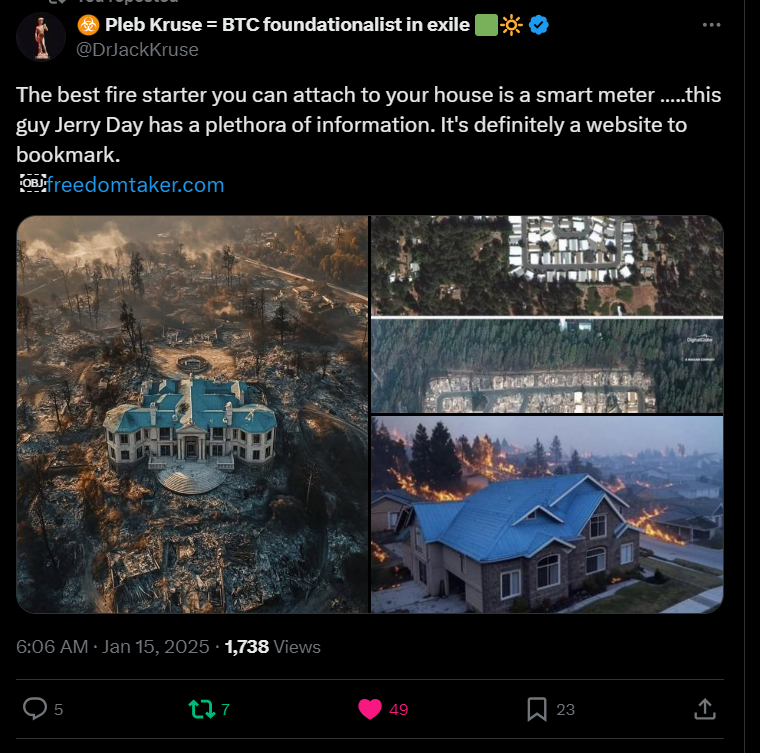QuantaDose Press Releases
Are Smart Meters Fueling Fires? A Deep Dive into Technology, RF Radiation, and Neighborhood Wildfires
Author’s Note: RF Safe has been at the forefront of advocating for safer wireless technologies since 1998. We’re committed to educating the public about the risks of electromagnetic radiation and promoting innovative solutions to protect your health and safety.
Featured Image

(Insert the tweet screenshot featuring Dr. Jack Kruse’s claim about smart meters being a “fire starter.”)
A Question Worth Asking
Wildfires like those that ravaged Palisades, CA—destroying over 12,000 structures—have prompted tough questions about how modern technology might be amplifying fire risks, especially in densely populated neighborhoods. Dr. Jack Kruse’s provocative statement that smart meters might act as “fire starters” deserves a closer look. While the official narrative often points to embers, wind, and dry vegetation as the main culprits, it’s essential to investigate whether our conveniences—like battery-powered smart meters—could be contributing to or exacerbating these devastating events.
For more than 25 years, RF Safe has raised awareness of the potential dangers of microwave radiation and other “entropic waste” caused by wireless technologies. This discussion isn’t just about potential radiation hazards; it’s also about understanding how devices like smart meters and lithium-ion batteries might intensify the destruction once fires ignite.
What Are Smart Meters and Why the Controversy?
Smart Meters 101
Smart meters are digital devices designed to replace traditional analog utility meters, measuring electricity, gas, or water usage. They allow two-way communication between the utility company and the consumer, enabling real-time usage monitoring and remote meter reading.
- Microwave Radiation Exposure
Many smart meters emit non-ionizing microwave radiation to transmit data wirelessly. At RF Safe, we argue that cumulative exposure to these signals—especially when added to emissions from cell phones, Wi-Fi, and other devices—poses a biological risk, even at non-thermal levels. - Battery Backup Concerns
Some smart meter models contain lithium-ion batteries for backup power, ensuring functionality during outages. While these batteries are typically small, lithium-ion technology is inherently sensitive to heat. When subjected to extreme conditions—like those in a wildfire—these batteries could enter thermal runaway (an uncontrollable chain reaction of overheating and ignition).
Lithium-Ion Batteries and Fire Risk
The Science of Thermal Runaway
Lithium-ion batteries, prized for their high energy density, are used in everything from smartphones and laptops to electric vehicles (EVs). Unfortunately, they are also well-known for potential overheating incidents that can lead to fires or even explosions.
- Battery Size Matters
While the lithium-ion batteries in smart meters are smaller than those in EVs or power walls, the risk of thermal runaway still exists under extreme heat conditions—such as intense wildfire environments. - Wildfire Proximity
In a wildfire zone, surrounding radiant heat could cause these small batteries to overheat. Even if a smart meter’s battery is modest, ignition could spread to nearby combustible materials, accelerating the fire. - Electrical Sparks and Arcing
Fire risk isn’t limited to the battery itself. Smart meters can spark if they are physically damaged or installed improperly, potentially igniting fires in walls or attics.
Dr. Jack Kruse’s Claim—A “Fire Starter”?
Dr. Kruse poses a critical question: Could the lithium-ion backups in smart meters have contributed to the rapid spread of wildfires in Palisades, CA? With over 12,000 destroyed structures, it’s unknown how many of these homes had battery-equipped smart meters and whether those units might have ignited or exacerbated the fires.
RF Safe’s Perspective
At RF Safe, we believe these questions are not just valid but essential. Official investigations typically focus on traditional wildfire drivers (i.e., embers, vegetation, weather) without delving deeply into modern electrical infrastructures. Yet:
- Cumulative Technology Risks
From smart meters to EVs and power walls, our homes are more energy-dense than ever before. Could this shift be creating neighborhoods far more vulnerable to uncontrollable fires? - Microwave Radiation Exposure
Our organization has extensively documented the potential biological effects of low-level, non-ionizing radiation. While the immediate hazard in a wildfire scenario is clearly the fire itself, microwave radiation could also degrade wiring insulation over time, increasing the chance of electrical faults and ignition. - Transparency Gap
Utility companies often fail to communicate how these meters are designed, tested, or protected. Are the lithium-ion batteries housed in fire-resistant casings? Are they tested under extreme conditions? The public deserves transparent answers.
The Bigger Picture—Lithium-Ion Tech in Modern Neighborhoods
EVs, Power Walls, and Beyond
As technology evolves, homes are increasingly equipped with large lithium-ion battery systems. Electric vehicles can store hundreds of kilowatt-hours of energy in their batteries, while solar power systems often include home-mounted “power walls.” These conveniences bring sustainability but also a heightened fire risk:
- EV Fires
Electric vehicle battery fires are extremely hot, challenging to extinguish, and can reignite hours or even days later. - Power Walls & Home Storage
When power storage batteries ignite, the fire can burn hotter and spread faster, especially if multiple homes in a neighborhood have such systems. - Cascading Failures
In tightly packed suburban areas, a single battery fire can jump from one house to the next, triggering other lithium-ion systems to ignite.
A New Era of Wildfire Risk
Historically, wildfires were driven by natural factors—dry brush, wind, heat. Now, human-made energy systems are fueling fires in ways never seen before:
- Lightweight Building Materials
Modern homes often use synthetic, combustible materials that can accelerate fire spread. - Close Proximity
Suburban sprawl puts homes closer together, facilitating a chain reaction if one house catches fire. - Firefighting Challenges
Lithium-ion battery fires require specialized techniques; standard water or foam can be ineffective. This reality leaves emergency responders at a disadvantage.
Smart Meter Fires—What the Research Says
The Discovery and Science of Smart Meter Fires
Recent investigations have documented multiple cases where smart meters were implicated in home fires. These fall into three main categories:
- Mechanical or Design Failures
Overheating components, water damage, or faulty internal batteries can spark electrical fires. - Connection Problems at the Meter/Base Interface
Improper installation—e.g., forcing the smart meter onto the base—can lead to arcing or loose connections. - Remote Ignitions via RF Radiation
Perhaps the most concerning, certain studies suggest that RF radiation from smart meters may degrade wiring insulation over time. This can cause arc tracking—where electricity jumps across damaged insulation—leading to ignition in walls or attics.
PVC Insulation Breakdown
RF pulses can create localized “hot spots” of energy, potentially heating and charring PVC insulation. Once the insulation degrades, electrical current can arc through carbonized pathways, igniting surrounding materials.
Thermal Runaway in Plastic Insulation
Unlike ionizing radiation, RF energy causes dielectric heating, which can degrade or char plastic insulation. Over long periods, this silent process may culminate in a house fire—even without external catalysts like severe weather.
What We Know vs. What We Don’t
- What We Know
- Some smart meters do have lithium-ion batteries prone to thermal runaway in extreme heat.
- Wildfire temperatures could be enough to trigger battery ignition.
- Electrical infrastructure (lines, transformers, meters) has been implicated in past fires.
- What We Don’t Know
- Exactly how many homes destroyed in the Palisades had battery-powered smart meters.
- Whether meters directly worsened the fire damage.
- The full extent of utility companies’ safety testing for extreme conditions like wildfires.
A Call for Accountability and Safety
RF Safe’s Stance
As an advocate for safer wireless technologies, RF Safe calls on utility companies, regulators, and consumers to push for greater transparency and improved safety measures:
- Disclose Smart Meter Designs
- Are lithium-ion batteries standard?
- What fire safety features are included to prevent thermal runaway?
- Conduct Independent Fire-Risk Assessments
- Investigate the role of smart meters in past wildfires.
- Determine whether these devices pose a significant ignition risk.
- Offer Radiation-Free Alternatives
- Consumers should have the option to opt out of wireless meters in favor of safer, hardwired models.
- Enhance Installation Training and Checks
- Ensure installers are well-trained to avoid faulty connections and potential arcing.
- Require post-installation inspections to catch hidden risks in walls or meter bases.
- Promote Fire-Resistant Building Codes
- Adopt materials and designs that can better withstand extreme heat.
- Encourage firebreaks and defensible space between homes in wildfire-prone regions.
- Accelerate Alternative Battery Technologies
- Explore solid-state batteries and other innovations less prone to thermal runaway.
- Encourage collaborative research among utilities, manufacturers, and fire-safety organizations.
Is Modern Convenience Adding Fuel to the Fire?
Dr. Jack Kruse’s question—whether smart meters, particularly those with lithium-ion backups, contributed to the Palisades fires—is part of a broader, urgent conversation. Our neighborhoods are increasingly packed with high-energy, lithium-ion-powered technologies—smart meters, electric vehicles, power storage systems—that may turn ordinary homes into potential accelerants. Meanwhile, the microwave radiation emitted by these devices continues to be downplayed, despite mounting evidence of long-term biological and structural risks.
At RF Safe, we believe that safeguarding both our health and our homes should be non-negotiable. We’ve spent decades spotlighting the concerns around electromagnetic radiation; now we’re also witnessing how some modern technologies might amplify wildfire damage in ways we never anticipated.
The Bottom Line:
Modern conveniences—from smart meters to EVs and beyond—have benefits, but they also bring significant risks if not properly designed and regulated. We need transparent data, independent investigations, and meaningful oversight to ensure these devices don’t become hidden fire starters. By demanding accountability from utility companies and policymakers, we can work toward solutions that protect our families, our homes, and our planet from the potentially devastating intersection of technology and wildfire.
Further Reading and Resources
- RF Safe Official Website: rfsafe.com
- Learn More About Lithium-Ion Fire Risks: National Fire Protection Association (NFPA)
- Explore Smart Meter Studies and Reports: Various consumer advocacy groups and independent research organizations provide ongoing studies into potential smart meter hazards.
Have you experienced issues or concerns with your smart meter? Share your story in the comments below, and let’s keep this critical conversation going. By staying informed and demanding safer technologies, we can better protect ourselves and our communities from the unseen risks of modern convenience.
